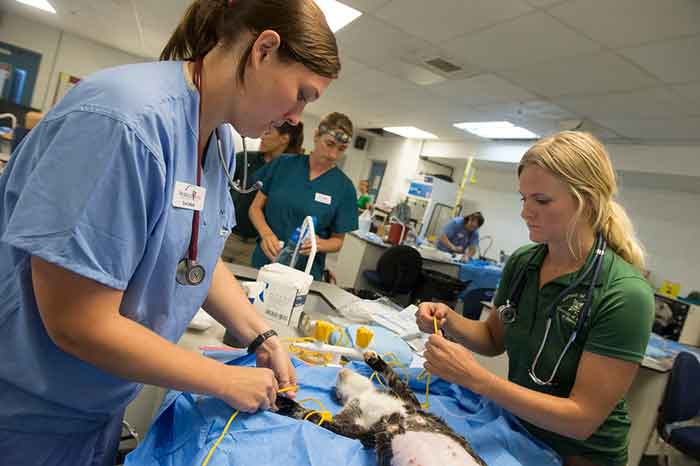
It will allow you to get a great job and do something meaningful. Working with animals is a dream for many people.
But what do you have to do to become a veterinary assistant?
What can you do to make sure that you will get the position that you are attempting to get?
If you truly wish to become a veterinary assistant, there are a few steps to the process. There are also a few things you can do that will make you a more attractive candidate for anyone looking to hire.
Here are some tips on how to become a vet assistant.
How Long Does it Take to Become a Veterinary Assistant?
In short, becoming a veterinarian assistant can take as little as a few months and as much as several years. Realistically, it depends on what the employer requires as far as formal education.
Generally speaking, formal education programs tend to be the best path forward because many veterinary clinics require experience handling animals.
It usually increases your odds of finding a job and receiving higher pay, even if offices in your area don’t require that hands-on experience. Here are some timelines for the different paths you can take.
1. In-Person Courses (3-6 Months)
One of the most popular options for learning how to become a vet assistant, albeit the most expensive, is taking in-person courses.
In fact, there are dozens of programs available around the US approved by the National Association of Veterinary Technicians in America (NAVTA) and the American Veterinary Medical Association. However, this is only necessary for those wanting to become a veterinary technician, which has different requirements since they administer anesthesia.
For vet assistants, the path toward education is much easier. Instead of having to go through the licensing process, vet assistants may start working after a short course.
Usually, in-person programs last anywhere from 90-180 days and teach much of the same material as a college program. The added benefit is that it provides you with hands-on experience with animals, which is one of the main considerations for vet offices and hospitals when hiring.
2. Online Courses (6-12 Months)
For those who aren’t near a vet assistant school, online courses are a great option.
While they typically take a little more time to complete, they provide the same foundational knowledge as in-person courses. In addition, they are generally much cheaper, making them more accessible to those looking for a career change.
The main reason why online courses take longer than in-person classes is because they are usually self-paced. This means that if you can only commit a certain number of hours to your studies per week, you’re free to follow an alternative schedule.
Self-paced options aren’t offered by most in-person institutions, so online courses are the way to go if you are working a full-time job at the same time or have other commitments.
3. Apprenticeship (12+ Months)
Another good option for some learners is finding an apprenticeship. While these aren’t as common as formal classes, they offer unmatched experience. The most difficult part of an apprenticeship in this day and age is finding a mentor that’s willing to teach you.
However, if you happen to find a vet professional open to this idea, you’ll likely have more flexibility than with other learning options. That being said, mentors typically look for individuals dedicated to their line of work rather than those casually trying it out.
Vet Assistant Requirements
When figuring out how to become a vet assistant, many students assume that states require some sort of credential, but a professional certification or license isn’t legally required to become a vet assistant.
While this means it’s possible to find a job as a vet assistant without any formal training, it’s unlikely that you’ll find a job that doesn’t require experience.
Have A Love For Animals
If you enjoy your work, you never work a day in your life.
So, if you love to work with animals, a job where you work with them is perfect. If you don’t like animals, or you don’t like the unpredictability of them, you’re probably going to hate the job.
Having a love for animals also makes it much easier for you to show them the proper care and compassion, and as caring for the animals at the veterinary office is usually the task of an assistant, it is essential to making the process easier for you.
A love for animals will also help to propel you through the not-so-pleasant tasks that your veterinarian is likely to require of you. Tasks like holding the animal down while they need their blood drawn, or collecting stool samples, or walking the dogs while they’re in the care of the office.
Get A Basic Education On The Tasks
Veterinary assistants are not expected to be experts, but they are expected to have some basic knowledge about dealing with the animals in their care.
If you’re looking to get a job as a veterinary assistant, you are going to want to take a course. Stratford Career Institute offers a Veterinary Assistant Course to equip you with the basic information you’ll need for the job.
In some cases, you can get this basic training elsewhere, or even on the job, but if you’re applying for a job at a veterinarian’s office, they are more likely to consider you for the position if you have some training.
Correspondence and distance-learning courses are great for learning how to be a veterinary assistant and learning the skills needed on your own schedule and at your own pace.
Volunteer
There are a few things that look better on a resume than volunteer work.
When it comes to the veterinary work, there are ample opportunities to volunteer and take care of animals. Go down to your local ASPCA or animal shelter, and they’re likely to take you on as a volunteer immediately.
You can also work at the city pound, assuming that your city still maintains a pound (some cities do not), which will help you accrue experience on-the-job as a vet assistant.
Find A Local Veterinary Office You’d Like To Work For
Now that you’ve decided on this veterinarian assistant career path for yourself, you should begin to apply to local veterinary offices that you would like to work at.
Although you may have a preference as to where you work, you are going to want to apply to multiple different locations, just in case. Having multiple job offers allows you to pick the one you like best, as well as improving your ability to negotiate on hours, pay, and more.
Now that you’ve set off on a journey to be a veterinary assistant, you’re likely to spend long hours with animals. But if you love animals, you will always find reward in this work.
Special Considerations Regarding Location
One thing to remember is that not every state or city has the same demand for vet assistants.
In some cases, you may have to consider what opportunities exist outside of your current location. Thankfully, the Bureau of Labor Statistics provides information on where vet assistant jobs are most popular and pay the most.
As of 2021, the states of California, Florida, and Texas have the highest number of employed vet assistants. However, these states don’t pay the most. Instead, the state with the highest pay is Maine, with an average salary of $40,900.
Another thing to consider is the concentration of jobs available in any given area. Contrary to what you might expect, the states with the highest employment of vet assistants don’t necessarily have the most available jobs.
Currently, the five states with the highest concentration of vet assistant jobs are Maine, Oregon, Virginia, Washington, and Arkansas.
Enroll in a Vet Assistant Online Course
Taking an introductory course about becoming a veterinary assistant, is a great way to get your career started. Consider taking the vet assistant course offered by the Stratford Career Institute.
Enroll today!

Get Vet Assistant Training at Stratford

Our training program will give you a solid base of knowledge. A career as a vet assistant can be extremely rewarding!


